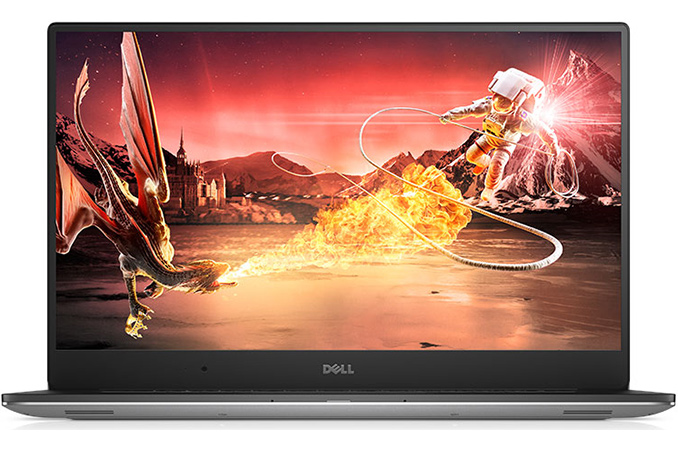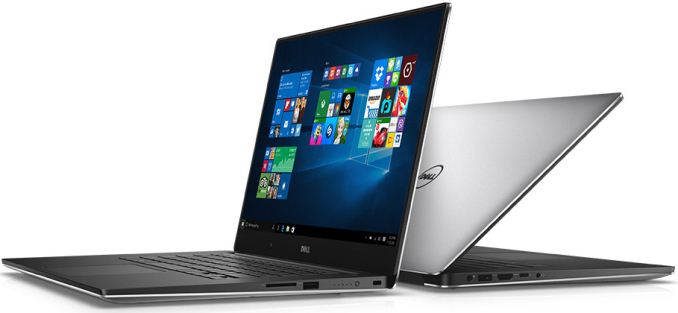Dell Readies New XPS 15: 4K, Quad-Core Kaby Lake, GeForce GTX 1050
by Anton Shilov on December 23, 2016 4:00 PM EST
Dell has accidentally published near-final specifications of its upcoming XPS 15 notebook due to be released early next year. The Dell XPS 15 computers are designed for performance-demanding users seeking near bezel-less laptops with above-average performance at a moderate price with a plenty of upgrade options. The new XPS 15 9560 will receive Intel’s Kaby Lake processor, NVIDIA’s GeForce GTX 1050-series graphics as well as some other optional upgrades not available on current-gen, but will retain the internal architecture and external design.
According to the listing (now removed from the website) Dell’s upcoming XPS 15 9560 notebook will use either a dual-core Intel Core i3-7100HQ, a quad-core Core i5-7300HQ or a quad-core Core i7-7700HQ CPU. The aforementioned chips are not yet formally announced, but it is known that they are based on the Kaby Lake microarchitecture and will thus offer improved performance compared to predecessors due to higher frequencies, Speed Shift v2 technology and other refinements. For those who opt for iGPU rather than a discrete model it is important to note that the Kaby Lake CPUs also has an improved video encoding/decoding engine.
The next key enhancement of the XPS 15 9560 over the current-generation XPS 9550 will be NVIDIA’s GeForce GTX 1050 GPU with up to 4 GB of GDDR5 memory. NVIDIA has yet has to announce a mobile version of the GeForce GTX 1050, but it is highly likely that the product is based on the GP107 GPU featuring the Pascal architecture and up to 768 stream processors, similar to the desktop version. The new graphics chip should offer a decent performance upgrade when compared to the GeForce GTX 960M used in the current-gen XPS 15. Meanwhile for those planning to play demanding games it makes sense to look at the GeForce GTX 1060 or 1070, which means the Alienware 15.
Since the new Dell XPS 15 9560 will retain the chassis of its predecessor, it will support similar InfinityEdge 15.6” display panels: an IPS FHD (1920×1080) or an IGZO UHD (3840×2160) with 100% AdobeRGB color gamut and touch support. Physical dimensions of the unit also remain intact with the predecessor: it weighs around 1.8 kilograms and is up to 17 mm thick.
For storage, the new Dell XPS 15 will use either Seagate’s SSHDs or PCIe SSDs with up to 1 TB capacity. Meanwhile, due to improvements of Kaby Lake’s memory controller, the new laptops should be compatible with DDR4-2400 memory, offering an additional performance boost over DDR4-2133 used today.
As for connectivity, the XPS 9550 uses Rivet Networks' Killer 1535 802.11 2×2 Wi-Fi + BT 4.1 controller, has one Thunderbolt 3/USB 3.1 Type-C port, two USB 2.0 headers, an HDMI output, a 720p webcam and an SD card reader, which essentially means that there is nothing for the XPS 9560 to upgrade here (at least, not without a major redesign of the whole PC). However, since the XPS machines are often used like workstations, Dell decided to add a fingerprint reader with Windows Hello support as an option.
Since Dell has already taken down the XPS 9560 product page (technically, it is there, but without any data), so prices and exact final configurations / availability dates remain under wraps. Still, being a close partner of Intel and NVIDIA, Dell is typically among one of the first to release PCs based on the new CPUs/GPUs. Therefore we expect the new systems to arrive shortly after CES in the usual XPS 15 price range that starts at $999 and ends at ~$2500 for high-end models.
Related Reading:
- Best Gaming Laptops: Holiday 2016
- Alienware Refreshes The Alienware 15 And 17 Gaming Notebooks At PAX
- Razer Re-Launches The Razer Blade Pro: GTX 1080 And 4K G-SYNC
- The ASUS ROG Strix GL502VS Review: Mainstream GTX 1070 with G-SYNC
Sources: PCMag, WindowsCentral.


















102 Comments
View All Comments
fanofanand - Monday, December 26, 2016 - link
I believe the article mentioned the i3 being a dual-core. I'm not aware of any quad core i3s having ever existed.SpetsnazAntiVIP - Saturday, December 24, 2016 - link
It's a shame that Dell would use Killer wifi in this thing. I was thinking about selling my XPS 13 9350 and getting one of these, but not with garbage Killer wifi onboard. I suppose I can swap the wifi card tho...Flunk - Sunday, December 25, 2016 - link
I have the last gen version, changing the Wi-Fi card is fairly easy.perseid - Sunday, December 25, 2016 - link
What is the best wi-fi card for use with the Dell XPS 15?Zan Lynx - Tuesday, December 27, 2016 - link
I've got a 2016 Razor Blade Pro with the Killer WiFi and it seems very solid. I don't understand where all the hate comes from.With the bandwidth management turned off it gets a very solid 400 Mbps to a LAN server through my Netgear R7000. And with the management turned on it seems to do very well for gaming and web browsing.
Spunjji - Wednesday, December 28, 2016 - link
It's fine. People are weird.BrokenCrayons - Thursday, December 29, 2016 - link
Killer NICs are just as capable as any other wireless network adapters. However, the marketing speak used to sell them is questionable. They're advertised as being able to work magic with data packets that offer a better experience when the reality of networking makes it pretty clear the marketing is bogus. Another minor problem is Linux driver support or the lack thereof which, in a few (admittedly VERY few cases) requires a wifi adapter swap. So basically the grief about them is a somewhat over-inflated reaction to the features the company uses in advertising to differentiate their products from less expensive alternatives.nerd1 - Sunday, December 25, 2016 - link
So much better than new macbook *pro* LOLTEAMSWITCHER - Monday, December 26, 2016 - link
Let's hop Dell can find it in themselves to spec at least one of the better Intel Multi-IO chips so that this expensive laptop can have more than one Thunderbolt port. The MacBook Pro has FOUR!!! Once you learn the Dell tricks you realize your paying Apple Prices for shitty products.Spunjji - Wednesday, December 28, 2016 - link
Woohoo, four. For all four thunderbolt 3 peripherals on the market.